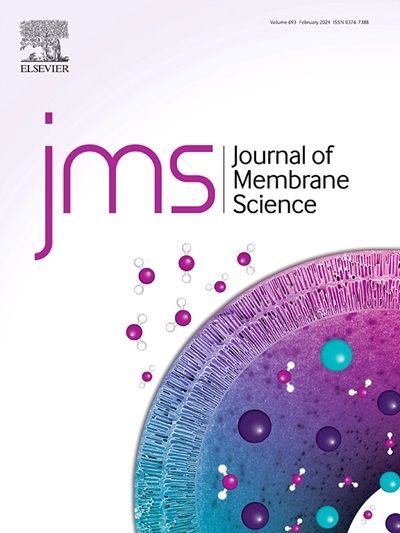Polyethylene Glycol Functionalized Alumina-Based Composite Membrane with High-performance for Alkaline Water Electrolysis
IF 8.4
1区 工程技术
Q1 ENGINEERING, CHEMICAL
引用次数: 0
Abstract
Green hydrogen is currently the dominant trend in the evolution of hydrogen energy, producing almost no greenhouse gas emissions. Alkaline water electrolysis (AWE) is recognized as a leading and well-established technology for producing green hydrogen. However, safety hazards may occur during hydrogen production currently as defective commercial separate membranes used in the AWE process. Therefore, it is imperative to create a membrane characterized by low area resistance, high stability, and high bubble point pressure (BPP) to realize high-performance AWE. Herein, we synthesize alumina-based composite membranes with Y2O3-added and polyethylene glycol functionalized Al2O3 for AWE through a phase inversion method. The porous composite membrane exhibits excellent hydrophilicity, with a lower contact angle of approximately 55°. It also presents exceptional performance metrics, including a low area resistance of about 0.17 Ω cm2, an ultra-high BBP of approximately 4.4 bar, and excellent mechanical properties with a tensile strength of around 25 MPa. The membranes achieved a current density of up to 2.5 A cm-2 under 2.0 V voltage in a 30 wt% KOH solution at 80 °C by utilizing commercial catalysts. Notably, the composite membranes exhibited remarkable stability, maintaining operation for over 1200 hours at a 2.0 A cm-2 current density without any performance degradation at 80°C. Furthermore, this composite membrane possesses outstanding gas-barrier capability with H2 and O2 purity higher than 98.70% and 99.69%, respectively. The above results demonstrate that the prepared novel high-performance alumina-based composite membrane for hydrogen generation has significant potential for applications within the AWE process.

求助全文
约1分钟内获得全文
求助全文
来源期刊

Journal of Membrane Science
工程技术-高分子科学
CiteScore
17.10
自引率
17.90%
发文量
1031
审稿时长
2.5 months
期刊介绍:
The Journal of Membrane Science is a publication that focuses on membrane systems and is aimed at academic and industrial chemists, chemical engineers, materials scientists, and membranologists. It publishes original research and reviews on various aspects of membrane transport, membrane formation/structure, fouling, module/process design, and processes/applications. The journal primarily focuses on the structure, function, and performance of non-biological membranes but also includes papers that relate to biological membranes. The Journal of Membrane Science publishes Full Text Papers, State-of-the-Art Reviews, Letters to the Editor, and Perspectives.
 求助内容:
求助内容: 应助结果提醒方式:
应助结果提醒方式:


